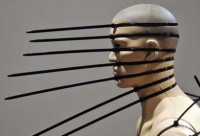JOANA VASCONCELOS
جوانا فاسكونسيلوس
琼娜巴斯孔塞洛斯
ג’ואנה אסקונסלוס
ジョアナ·ヴァスコンセロス
esposa
source: haunchofvenison
Joana Vasconcelos (b 1971 Paris) is considered the pre-eminent Portuguese artist of her generation. Finding inspiration in the popular imagination, and examining various themes of daily life, Vasconcelos focuses on the identity politics of gender, religion, class and nationality. While consistent in occupation, her approach remains exhilaratingly open-ended.
Following the principles of the 1960s art movement Nouveau Realisme and inspired by the readymades of Marcel Duchamp, Vasconcelos’ work frequently incorporates objects and materials from daily life into expansive and intricate assemblages.
Having pushed the boundaries of traditional crafts and techniques and the use of textiles as a medium, Vasconcelos crafts her work from a combination of pre-existing materials and mass-produced objects, along with hand-made crochet and knitted fabrics. Local women are invited to participate in the making process, while visitor interaction also features in other examples of the artist’s work, alongside elements of theatre and performance.
Explorations of womanhood are fundamental to Vasconcelos’ practice. Her interest in the feminine condition deals with issues associated with womanliness, family and conjugal life. The use of crochet alludes to an activity usually associated with women and traditional crafts, but in this instance such perceptions are rendered obsolete. Portuguese culture and history also feature in the form of traditional materials (ceramics), techniques (embroidery), and subject matter (maritime history).
I Will Survive – the title taken from Gloria Gaynor’s popular hit song – is the first survey show of Joana Vasconcelos to take place in London. Exploring the relationship between art, nature and technology and questioning our vision of future paradise or utopia, the exhibition transports us to the unique universe of the artist. As a witty and often provocative response to the way technological and ethical advancements affect traditional ideas, Vasconcelos has revelled in the challenges brought on by these accelerated changes and the unfettered freedom contemporary culture can provide in return.
Exploring the nature of reality in an age where so many of our ideas and means of communication have been radically modified, the notion of artifice is at the very heart of this: flowers are plastic, dogs are ceramic, people are foam. Vasconcelos’ oeuvre asserts itself as an antidote to the insipid and the banal; de-constructing the formulas governing contemporaneity, arousing the senses and challenging the crystallised frame of daily torpor with a fanciful sculptural installation of diaphanous colour.
Joana Vasconcelos came to public attention for her display at the 2005 Venice Biennale that greeted visitors to the Arsenale. Her sculpture A Noiva (The Bride) took the form of a grand chandelier made from around 25,000 tampons. Born in Paris, Vasconcelos now lives and works in Lisbon. She studied Visual Arts at the Ar.Co – Centro de Arte e Communicacao Visual between 1989 and 1996. In 2006, she won the award The Winner Takes It All from the Berardo Foundation. This enabled the creation of Nectar for the Berardo Collection Museum. In 2003 Vasconcelos won the Tabaqueira Fund for Public Art in Lisbon. In 2000, she won the Young Artists EDP Prize.
Commissions and site-specific public art installations assume a special relevance in Vasconcelos’ work. Some of the most recent and important of these are; La Theiere, Le Royal Monceau, Paris (2010); Sr. Vinho, Mercado Municipal de Torres Vedras, Torres Vedras (2010); Jardim Bordallo Pinheiro, Jardim do Museu da Cidade, Lisbon (2009); Varina, Ponte D. Luis I, Porto (2008); The Jewel of the Tagus, Tower of Belem, Lisbon (2008).
Vasconcelos has been exhibiting in Portugal and abroad since 1994, and her work is represented in both national and international private and public collections.
.
.
.
.
.
.
.
source: vespigwordpress
Работы португальской художницы Джоаны Васкончелос будут выставлены на всеобщее обозрение в Лондоне. Выставка пройдет в галерее «Haunch of Venison» (Оленья ножка), которая сотрудничает с художницей вот уже девять месяцев.
Выставка «Я выживу» переносит нас в мир вышивки и вязания, секса и фигур. Название этой работы – «Эспосас» – в зависимости от контекста может переводиться, как “замужняя женщина”, а может и как “наручники”.
.
.
.
.
.
.
.
source: ensaiosdeestoriaehistoriablogspot
Artista plástica portuguesa, de grande sucesso mundial. Alia o tradiçional e o contemporâneo. O seus temas, peças, exposições abordam isso mesmo, falam de uma Portugalidade, passada, perdida, que no entanto deve ser preservada, recolocada no mundo, na nova ordem de valores.
Joana Vasconcelos pretende revelar ao mundo uma certa modernidade do nosso pais, cultura. O seu atelier é hoje uma «fabrica», «industria», que emprega inumeras pessoas, artificies, faz escola pois é original, arrojada, procura na simplicidade e secularidade dos seus objectos o conjunto perfeito para a sua obra. Já fez exposições no locais mais conhecidos do mundo, nas bienais mais afamadas, é simbolo de marca, estilo, representa Portugal como ninguem. Merece todas as referências, elogios, a sua presença não deixa ninguem indiferente.
Joana Vasconcelos conquistou admiração dos grandes coleccionadores de arte contemporanea, em Portugal o Comendador Joe Berardo, cedo viu nela um grande talento, valor, fonte de rendimento, é dos grande benfeitores, colecionadore, mecenas do seu catalogo, honra lhe seja feita. A exposição que teve lugar no CCB durante meses em 2012, teve o patrocinio da Fundação Berardo. As obras mais significativas de JV estiveram expostas, para gaudio de todos, deixou-nos boqueabertos, a singularidade da sua obra, os materiais utilizados, em proporções gigantescas, temas onde a mulher, o pais, a portugalidade, a feminidade, o feminismo, as grandes formas, o transformismo, a recriação apartir do tradicional estão presentes.
Obra enquadrada na exposição «I will Survive», mais uma vez o tema que daí decorre é a critica á opressão, aos limites, á falta de liberdade do homem e da mulher, do casal enquanto tal. A simbolica de contenção está patenteada no uso das braçadeiras plasticas, que confinam, delimitam, prendem. Esta pesada imagem marca bem a revolta da autor fase a violencia, aos relaçionamentos tradicionais vazios de sentimentos, autora em imagem de fundo ela propria retrata-se nesta peça.
.
.
.
.
.
.
.
.
source: financeqq
幽默诙谐和女性特有的细腻风格,当代女艺术家琼娜的作品此前获得的评价褒贬不一,她本人则被认为是让人难以归类的怪才。“我热爱重新思考有关传统的一切,它赋予我很多当代的价值,让我从少数人的角度进行思考和创作,包括对于色彩的应用。比如说,女人通过家务和针织活来体现她们的创新意识。”琼娜在谈到创作的时候说道。


